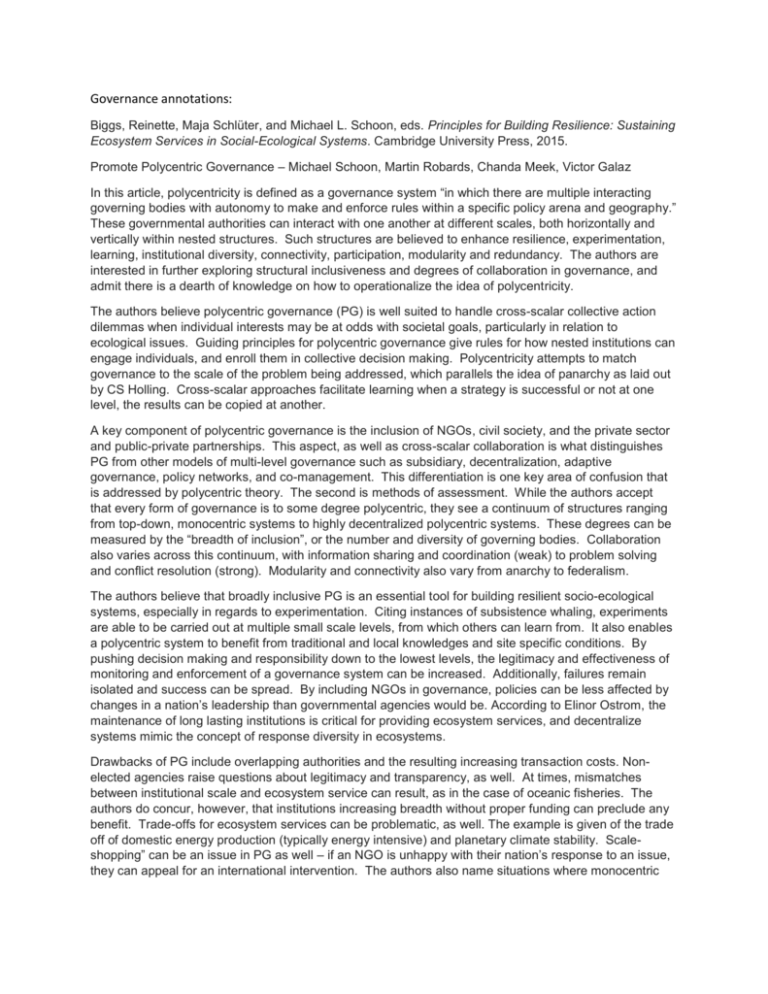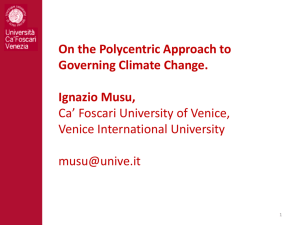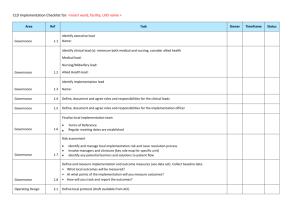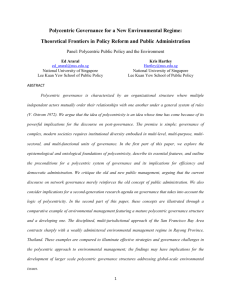Kellog Annotation Polycentric Governance
advertisement

Governance annotations: Biggs, Reinette, Maja Schlüter, and Michael L. Schoon, eds. Principles for Building Resilience: Sustaining Ecosystem Services in Social-Ecological Systems. Cambridge University Press, 2015. Promote Polycentric Governance – Michael Schoon, Martin Robards, Chanda Meek, Victor Galaz In this article, polycentricity is defined as a governance system “in which there are multiple interacting governing bodies with autonomy to make and enforce rules within a specific policy arena and geography.” These governmental authorities can interact with one another at different scales, both horizontally and vertically within nested structures. Such structures are believed to enhance resilience, experimentation, learning, institutional diversity, connectivity, participation, modularity and redundancy. The authors are interested in further exploring structural inclusiveness and degrees of collaboration in governance, and admit there is a dearth of knowledge on how to operationalize the idea of polycentricity. The authors believe polycentric governance (PG) is well suited to handle cross-scalar collective action dilemmas when individual interests may be at odds with societal goals, particularly in relation to ecological issues. Guiding principles for polycentric governance give rules for how nested institutions can engage individuals, and enroll them in collective decision making. Polycentricity attempts to match governance to the scale of the problem being addressed, which parallels the idea of panarchy as laid out by CS Holling. Cross-scalar approaches facilitate learning when a strategy is successful or not at one level, the results can be copied at another. A key component of polycentric governance is the inclusion of NGOs, civil society, and the private sector and public-private partnerships. This aspect, as well as cross-scalar collaboration is what distinguishes PG from other models of multi-level governance such as subsidiary, decentralization, adaptive governance, policy networks, and co-management. This differentiation is one key area of confusion that is addressed by polycentric theory. The second is methods of assessment. While the authors accept that every form of governance is to some degree polycentric, they see a continuum of structures ranging from top-down, monocentric systems to highly decentralized polycentric systems. These degrees can be measured by the “breadth of inclusion”, or the number and diversity of governing bodies. Collaboration also varies across this continuum, with information sharing and coordination (weak) to problem solving and conflict resolution (strong). Modularity and connectivity also vary from anarchy to federalism. The authors believe that broadly inclusive PG is an essential tool for building resilient socio-ecological systems, especially in regards to experimentation. Citing instances of subsistence whaling, experiments are able to be carried out at multiple small scale levels, from which others can learn from. It also enables a polycentric system to benefit from traditional and local knowledges and site specific conditions. By pushing decision making and responsibility down to the lowest levels, the legitimacy and effectiveness of monitoring and enforcement of a governance system can be increased. Additionally, failures remain isolated and success can be spread. By including NGOs in governance, policies can be less affected by changes in a nation’s leadership than governmental agencies would be. According to Elinor Ostrom, the maintenance of long lasting institutions is critical for providing ecosystem services, and decentralize systems mimic the concept of response diversity in ecosystems. Drawbacks of PG include overlapping authorities and the resulting increasing transaction costs. Nonelected agencies raise questions about legitimacy and transparency, as well. At times, mismatches between institutional scale and ecosystem service can result, as in the case of oceanic fisheries. The authors do concur, however, that institutions increasing breadth without proper funding can preclude any benefit. Trade-offs for ecosystem services can be problematic, as well. The example is given of the trade off of domestic energy production (typically energy intensive) and planetary climate stability. Scaleshopping” can be an issue in PG as well – if an NGO is unhappy with their nation’s response to an issue, they can appeal for an international intervention. The authors also name situations where monocentric responses may be more rapid and efficient – conflict and disaster scenarios – although they cite studies that speak to the increased effectiveness of ad hoc cooperation in disasters. In conclusion, the authors remark that it is not enough just to create polycentric systems, the proper social conditions much exist beforehand. These include: trust and social capital, strong leadership, social learning and bridging scales. Finally, there is an admission that much of the work done in the field of PG has been only theoretically informed, and more studies need to be done around PG systems that have failed, and more precise gradations of PG. Genealogy: Michael Schoon – School of Sustainability, ASU. Martin Robards – Wildlife Conservation Society, Chanda Meek – Department of Political Science, University of Alaska, Victor Galaz – Stockholm Resilience Center.











